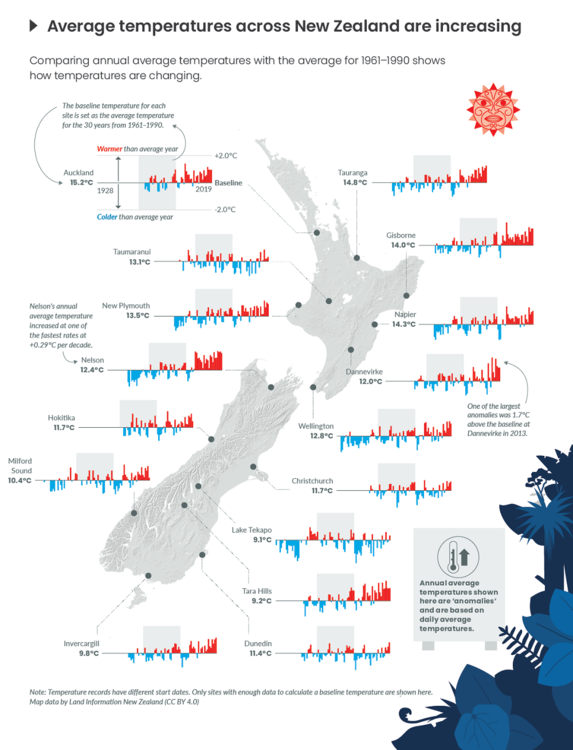Science knowledge is often communicated through visual representations – graphs, diagrams and infographics. Each type of visual representation has literacy components that students may need support to understand.
The science capability ‘Interpret representations’ encourages students to think about how data is presented, what the representation tells us and how it gets the message across.
Infographics provide an effective format to show a variety of things in a single figure. The article Understanding infographics provides background information on how they are constructed and why they are useful communication tools.
In this activity, students observe and interpret infographics from the Ministry for the Environment and Stats NZ’s Our atmosphere and climate 2020 report. The activity includes probing questions to help students understand the ways in which infographics present information. It also includes a simple framework for creating an infographic.
By the end of this activity, students should be able to:
- develop literacy skills for interpreting the information in an infographic
- discuss the purpose of an infographic
- discuss how an infographic gets the message across
- use this information to design and create a simple infographic.
Download the Word file (see link below).
Related content
The article Our atmosphere and climate – introduction has links to resources that inform students (and the general public) about the state of New Zealand’s climate.
This infographic from Our environment 2025 has a focus on the interconnectedness of all aspects of the environment to each other and to people. Use this infographic to explore the design fundamentals within a different context.
Climate change resources – planning pathways provides pedagogical advice and links to the New Zealand Curriculum. It includes an interactive planner that groups Hub resources into key science and teaching concepts.
The ClimateViz citizen science project needs help interpreting climate change graphics to help combat misinformation and support scientific communication.
The Department of Conservation and the Science Learning Hub have collaborated to create a series of interactives that feature many of DOC’s marine infographics.
- Marine diversity in Aotearoa New Zealand
- New Zealand marine habitats
- Threats to marine habitats
- Areas of marine ecological importance
- Mussel reefs and biodiversity
We've curated a selection of bilingual and reo Māori infographics and diagrams in this handy collection. Visual representations provide excellent opportunities to develop literacy practices and learn new information.
Related activities
These activities also support students to create and interpret visual representations using climate change data.
Te Kāhui o Matariki – interpreting infographics provides additional opportunities to explore the literacy components of infographics.
Viruses and immunity – interpreting infographics uses colourful infographics to learn about viruses, the immune system and staying safe.
Creating kōwhai infographics explains how to use infographics as a means of summarising students’ research findings.
Useful link
The Science Learning Hub has curated a number of infographics in our Science infographics Pinterest board.
Acknowledgement
This resource has been produced with the support of the Ministry for the Environment and Stats NZ. (c) Crown Copyright.


